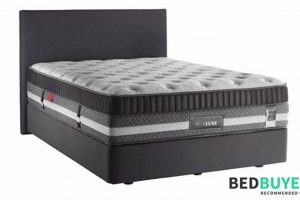A sleeping surface optimized for individuals who primarily rest on their abdomen offers specific characteristics that promote spinal alignment and minimize pressure points. These mattresses typically feature firmer constructions or zoning to prevent excessive sinking of the hips and torso, which can contribute to lower back pain. An example would be a hybrid mattress with a firm coil base and a comfort layer of responsive foam, designed to maintain a level sleeping plane.
The proper support during sleep is crucial for maintaining long-term musculoskeletal health. Prioritizing a sleep surface that accommodates this particular sleep position can mitigate discomfort, leading to more restful sleep and improved daytime function. Historically, little emphasis was placed on positional sleep needs; however, increasing awareness of the connection between sleep posture and well-being has driven demand for tailored sleep solutions.
Subsequent discussion will address key mattress features and materials beneficial for this specific sleep style, alongside consideration of factors such as body weight, personal preferences, and potential implications for common ailments.
Recommendations for Abdominal Sleepers
The following recommendations provide guidance for selecting a sleeping surface that accommodates the unique needs of those who sleep on their stomach. Attention to these details can significantly impact spinal alignment and overall sleep quality.
Tip 1: Prioritize Firmness. A firmer mattress prevents excessive sinkage in the midsection, maintaining a more neutral spinal posture. Consider models rated between 6-8 on a 1-10 firmness scale, with 10 being the firmest.
Tip 2: Evaluate Support Core. Innerspring or hybrid mattresses with robust coil systems offer substantial support. Look for models with reinforced edge support to prevent sagging and ensure consistent firmness across the sleeping surface.
Tip 3: Consider Zoned Support. Mattresses with targeted support zones can provide extra reinforcement in the hip area, further preventing spinal misalignment. These zones often utilize varying coil gauges or foam densities.
Tip 4: Explore Low-Profile Comfort Layers. Thick, plush comfort layers can exacerbate sinkage. Opt for thinner layers of responsive materials like latex or high-density foam that provide cushioning without sacrificing support.
Tip 5: Recognize Body Weight Influence. Individuals with higher body weights may require firmer mattresses to achieve adequate support. Conversely, those with lighter builds might find medium-firm options more comfortable.
Tip 6: Account for Personal Preference. While firmness is crucial, personal comfort is equally important. Experiment with different materials and constructions to identify a mattress that provides the optimal balance of support and cushioning.
Tip 7: Trial Periods and Return Policies. Take advantage of in-home trial periods offered by many mattress retailers. This allows for a thorough assessment of the mattress’s suitability for individual needs before committing to a purchase.
Adhering to these recommendations will increase the likelihood of selecting a sleeping surface that promotes healthy spinal alignment and minimizes discomfort for individuals who primarily sleep on their stomach.
The subsequent sections will delve into specific mattress materials and constructions that frequently align with the needs of abdominal sleepers.
1. Firmness Level
Firmness level constitutes a critical determinant in evaluating the suitability of a sleeping surface for individuals who primarily sleep on their stomach. A direct correlation exists between mattress firmness and spinal alignment in this sleep position. Insufficient firmness allows the hips and torso to sink excessively into the mattress, creating a U-shaped curvature of the spine. This misalignment can lead to lower back pain, neck strain, and restricted breathing due to compressed organs. Therefore, a firmer surface is generally recommended to maintain a more neutral spinal posture.
Consider, for example, an individual weighing 180 pounds who prefers sleeping on their stomach. A plush or medium-soft mattress (rated 3-5 on a 1-10 firmness scale) would likely result in significant sinkage, causing spinal misalignment and discomfort. In contrast, a firm or extra-firm mattress (rated 7-10 on a 1-10 scale) would provide the necessary support to prevent excessive sinkage and maintain a straighter spinal alignment. The practical significance lies in the direct impact on musculoskeletal health; choosing an appropriately firm mattress can mitigate pain and promote restful sleep.
In summary, the firmness level of a sleeping surface is paramount for stomach sleepers. It directly influences spinal alignment, pressure distribution, and overall comfort. While personal preferences may vary, a general guideline leans toward firmer mattresses to prevent spinal misalignment and its associated health consequences. The challenge lies in balancing the need for support with individual comfort preferences. Careful consideration of firmness level is essential for achieving optimal sleep posture and long-term well-being for those who favor the prone position.
2. Spinal Alignment
Spinal alignment constitutes a foundational element in the selection of a suitable sleep surface for individuals who adopt a prone sleeping position. The primary goal in optimizing sleep posture is the minimization of stress on the musculoskeletal system, and this is directly achieved through the maintenance of neutral spinal curvature. Stomach sleeping, by its nature, presents challenges to achieving this neutrality due to the inherent tendency for the midsection to sink, leading to hyperextension of the lower back and potential rotation of the neck. Consequently, a mattress designed for abdominal sleepers must actively counteract these forces.
The impact of spinal alignment, or lack thereof, manifests in various ways. Chronic lower back pain is a common consequence of sleeping on a mattress that allows excessive sinkage. Over time, this sustained misalignment can contribute to degenerative disc disease, sciatica, and other related conditions. Furthermore, the unnatural twisting of the neck, often observed in stomach sleepers who attempt to breathe comfortably, can lead to chronic neck pain, headaches, and even thoracic outlet syndrome. The practical application of this understanding lies in the selection of a mattress that provides adequate support to the hips and torso, preventing excessive sinkage and promoting a more level spinal profile. Examples include mattresses with reinforced lumbar support or those constructed with high-density foams that resist compression. Selecting the correct firmness level also plays an important role; a mattress too soft will not provide adequate support, while one
that is excessively firm may create pressure points and discomfort.
In conclusion, the relationship between spinal alignment and the appropriate sleeping surface for stomach sleepers is critical. The selection process must prioritize mattresses designed to maintain a neutral spinal posture, mitigating the risks of musculoskeletal pain and promoting restful, restorative sleep. Addressing the challenges inherent in abdominal sleeping through informed mattress selection represents a proactive approach to long-term health and well-being. Therefore, carefully evaluating a mattress’s ability to promote and sustain spinal alignment is a fundamental aspect of making an informed purchase decision.
3. Pressure Relief
Optimal pressure relief is an essential attribute of any sleeping surface, playing a crucial role in the quality of sleep experienced, particularly for individuals who primarily sleep on their stomach. While spinal alignment is paramount for this sleep position, adequate pressure relief prevents the formation of pressure points that can disrupt sleep and cause discomfort.
- Shoulder and Hip Accommodation
Stomach sleeping inherently concentrates body weight on the shoulders and hips. Mattresses designed for this position must incorporate materials that can contour to these areas, distributing weight and minimizing concentrated pressure. Materials such as memory foam or responsive latex, often used in the comfort layers, can effectively alleviate pressure on these joints. Without adequate accommodation, sleepers may experience localized pain and restless sleep.
- Chest Compression Mitigation
The prone position can lead to chest compression, which can potentially restrict breathing and increase discomfort. While a firmer overall mattress is necessary for spinal alignment, a comfort layer that provides gentle cushioning can mitigate this compression. Mattress designs incorporating zoned support can further alleviate pressure by providing targeted cushioning to the chest area.
- Internal Organ Support
Although often overlooked, pressure relief also extends to the internal organs. Excessive sinkage in the midsection can compress abdominal organs, potentially disrupting digestion and increasing discomfort. A mattress that maintains a relatively level sleeping surface distributes weight more evenly, reducing pressure on these internal structures. This is particularly pertinent for individuals with pre-existing digestive conditions.
- Micro-Pressure Relief and Circulation
Micro-pressure relief refers to the mattress’s ability to prevent even minor pressure points that can impede blood circulation. Prolonged pressure on capillaries can lead to numbness and tingling, disrupting sleep. Materials with open-cell structures or convoluted surfaces can enhance airflow and reduce localized pressure, promoting healthy circulation throughout the night. This is beneficial for all sleepers, but especially relevant for those who spend prolonged periods in a prone position.
By thoughtfully addressing pressure relief in conjunction with the need for firm support and spinal alignment, the ideal sleeping surface can effectively accommodate the unique needs of individuals who sleep on their stomach, promoting restful and restorative sleep. The synthesis of these factors is crucial in creating a mattress that supports both musculoskeletal health and overall sleep quality.
4. Material Composition
The constituent materials of a sleep surface exert a significant influence on its suitability for abdominal sleepers. The interplay between support, pressure relief, and thermal regulation is largely determined by the specific materials employed in the construction of a mattress. Therefore, a thorough understanding of material properties is crucial in selecting an appropriate option.
- Core Support Materials: Innerspring vs. Foam
The core of a mattress provides the primary support structure. Traditional innerspring systems offer robust support and airflow but can lack precise contouring. High-density foams, such as polyurethane or latex, offer consistent support and can be engineered with varying firmness levels. Hybrid mattresses combine innerspring systems with foam layers, seeking to balance support and pressure relief. The choice between these core types directly impacts the mattress’s ability to prevent excessive sinkage in the midsection, a key consideration for stomach sleepers. For example, a high-coil count innerspring system, coupled with a firm foam layer, provides stability and prevents the spinal misalignment associated with softer materials.
- Comfort Layer Materials: Memory Foam, Latex, and Polyfoam
The comfort layer is responsible for pressure relief and surface comfort. Memory foam conforms closely to the body, distributing weight and alleviating pressure points, but can trap heat. Latex is a more responsive material, offering both pressure relief and breathability. Polyfoam provides a more general level of cushioning and is often used in transitional layers. For stomach sleepers, thinner comfort layers made of responsive latex or high-density polyfoam are often preferable, as they provide cushioning without sacrificing the necessary underlying support. A thick memory foam layer, while comfortable initially, can contribute to excessive sinkage and spinal misalignment over time.
- Cover Materials: Breathability and Surface Feel
The mattress cover plays a critical role in thermal regulation and surface feel. Breathable materials, such as cotton or bamboo, promote airflow and help dissipate heat, preventing overheating during sleep. Tightly woven covers can limit airflow and contribute to a warmer sleep environment. For stomach sleepers, who often experience increased pressure on the chest and abdomen, a breathable cover is particularly important. Furthermore, the surface texture of the cover can impact overall comfort; a smooth, non-irritating fabric can minimize discomfort and promote restful sleep.
- Specialty Materials: Gel Infusions and Phase Change Materials
Gel infusions and phase change materials (PCMs) are often incorporated into comfort layers to enhance thermal regulation. Gel infusions are designed to draw heat away from the body, while PCMs absorb and release heat to maintain a consistent temperature. While these materials can improve overall sleep comfort, their effectiveness varies depending on the specific formulation and environmental conditions. For stomach sleepers prone to overheating, mattresses incorporating these technologies may offer a marginal benefit, but their impact on spinal alignment and support remains secondary to the core support and comfort layer materials.
In summary, the selection of constituent materials plays a pivotal role in determining the suitability of a mattress for stomach sleepers. Core support materials dictate the overall firmness and prevention of sinkage, while comfort layer materials balance pressure relief and spinal alignment. Cover materials influence thermal regulation and surface feel. Understanding the properties of each material and their interactions is essential in selecting a mattress that promotes optimal sleep posture and overall comfort for abdominal sleepers. The ideal composition depends on individual preferences and body ty
pe, but a general guideline emphasizes firm support, minimal sinkage, and adequate breathability.
5. Edge Support
Edge support, the reinforcement provided along the perimeter of a mattress, directly impacts the usability and long-term durability, particularly for individuals who favor the stomach-sleeping position. The connection between edge support and a suitable sleeping surface stems from the tendency of stomach sleepers to utilize the entire mattress surface, often positioning themselves near the edges. Insufficient edge support results in compression and sagging along the perimeter, leading to a sloped sleeping surface. This slope compromises spinal alignment, as the sleeper’s body is no longer uniformly supported, causing the spine to curve unnaturally. An example is a stomach sleeper experiencing increased lower back pain after sleeping near the edge of a mattress lacking adequate support. This demonstrates the direct cause-and-effect relationship between edge support deficiency and compromised spinal health. Effective edge support is thus a critical component of a mattress designed to facilitate proper spinal alignment for stomach sleepers.
The practical significance of robust edge support extends beyond spinal alignment. Individuals often sit on the edge of the mattress to dress or perform other activities. Weak edge support can accelerate wear and tear, reducing the overall lifespan of the mattress. Furthermore, robust edge support provides a more stable surface for couples sharing a bed, minimizing motion transfer and preventing the feeling of rolling off the mattress. Consider a scenario where two individuals share a bed, and one is a stomach sleeper who frequently moves closer to the edge. Without adequate edge support, the other sleeper may experience noticeable disturbances and discomfort, disrupting their sleep quality. This situation underscores the importance of considering edge support as a factor in overall sleep satisfaction and mattress longevity.
In summary, the connection between edge support and a suitable sleep surface for stomach sleepers is multifaceted. It is not merely an aesthetic consideration, but a critical component affecting spinal alignment, mattress durability, and sleep quality. Mattresses with reinforced edges provide a more stable and usable sleep surface, minimizing the risk of spinal misalignment and extending the lifespan of the product. The integration of robust edge support addresses challenges inherent in prone sleeping, contributing to a more comfortable and supportive sleep experience. Therefore, evaluating edge support should be a primary focus when selecting a mattress designed to accommodate the specific needs of stomach sleepers.
6. Long-term Durability
The longevity of a sleep surface constitutes a critical factor in determining its overall value, particularly for individuals who prioritize a stomach-sleeping position. Mattresses designed for this sleep style often require specific features to promote spinal alignment and pressure relief. The preservation of these features over time directly influences the continued suitability of the mattress and its capacity to provide consistent support.
- Material Degradation and Support Erosion
Mattress materials inevitably degrade over time due to compression and wear. Foams lose their resilience, coil systems can weaken, and fibers can break down. This degradation directly impacts the mattress’s ability to maintain proper spinal alignment for stomach sleepers. A mattress that initially provided adequate support may gradually lose firmness, leading to excessive sinkage and compromised posture. High-quality materials and robust construction techniques mitigate this degradation, extending the mattress’s lifespan and ensuring consistent support. For instance, a mattress with high-density foam and tempered steel coils will generally exhibit greater resistance to degradation than a mattress with lower-quality components.
- Sagging and Body Impressions
Sagging and body impressions are common indicators of reduced mattress durability. These depressions form in areas where the sleeper’s weight is concentrated, leading to uneven support and discomfort. For stomach sleepers, sagging in the midsection can exacerbate spinal misalignment, negating the benefits of a previously supportive mattress. Mattresses with reinforced support zones and resilient materials are less prone to sagging, maintaining a more uniform sleeping surface over time. This is particularly important for stomach sleepers, who require consistent support to prevent hyperextension of the lower back.
- Edge Support Deterioration
As previously discussed, edge support is crucial for maximizing the usable surface area of a mattress and preventing roll-off. Over time, edge support can weaken, particularly in mattresses constructed with lower-density foams or inadequate reinforcement. This deterioration can further compromise spinal alignment and reduce the overall comfort of the mattress. Models with reinforced edge support, such as those employing high-density foam encasements or perimeter wire supports, exhibit greater resistance to degradation and maintain their structural integrity over the long term. This is beneficial for stomach sleepers who tend to utilize the entire mattress surface.
- Warranty Coverage and Material Quality
Warranty coverage often reflects a manufacturer’s confidence in the durability of their product. Longer warranties typically indicate a higher level of material quality and construction standards. However, it’s important to carefully review the terms of the warranty, as they often exclude certain types of damage or degradation. The quality of the materials used in the mattress construction is a strong predictor of its long-term durability. High-density foams, tempered steel coils, and durable cover fabrics are generally indicative of a longer lifespan and greater resistance to wear and tear. Investigating the materials used and understanding the warranty terms is critical in assessing the long-term value of the mattress.
The interplay of these factors determines the ultimate long-term suitability of a mattress for stomach sleepers. Prioritizing mattresses constructed with durable materials, robust support systems, and reinforced edge support ensures consistent spinal alignment and pressure relief over an extended period. While initial comfort and support are important considerations, long-term durability ultimately dictates the ongoing value and effectiveness of the sleeping surface. Investing in a durable mattress represents a commitment to sustained sleep quality and musculoskeletal health.
Frequently Asked Questions
The following addresses common inquiries regarding the selection and use of mattresses tailored to individuals who predominantly sleep on their stomachs.
Question 1: How critical is firmness level for spinal alignment when sleeping prone?
Firmness level is paramount. Insufficient firmness results in excessive sinkage, leading to spinal misalignment and potential lower back pain. A mattress rated between 6 and 8 on a 1-10 firmness scale (10 being firmest) is generally recommended to maintain a neutral spinal posture.
Question 2: Can any mattress type be suitable for a stomach sleeper with proper modifications?
While modifications, such as
using a thin pillow or no pillow at all, can improve comfort, certain mattress types are inherently better suited. Innerspring or hybrid models with robust coil systems and minimal plush comfort layers are generally preferred over all-foam constructions that may lack sufficient support.
Question 3: How does body weight influence mattress selection for stomach sleepers?
Body weight directly impacts the required firmness level. Individuals with higher body weights typically require firmer mattresses to prevent excessive sinkage and maintain proper spinal alignment. Conversely, those with lighter builds may find medium-firm options more comfortable.
Question 4: Is it possible to achieve adequate pressure relief while maintaining proper support for a prone sleeper?
Yes, the key lies in selecting a mattress with a firm support core and a thin, responsive comfort layer. Materials such as latex or high-density foam provide cushioning without sacrificing the necessary underlying support. Zoned support systems can also provide targeted pressure relief to specific areas, such as the shoulders and hips.
Question 5: What role does edge support play in the suitability of a mattress for stomach sleepers?
Edge support is crucial for maximizing the usable surface area of the mattress and preventing roll-off. Weak edge support can compromise spinal alignment and reduce overall comfort, particularly for individuals who tend to sleep near the edges of the bed. Mattresses with reinforced edges provide a more stable and consistent sleeping surface.
Question 6: How can one assess the long-term durability of a mattress designed for stomach sleepers?
Evaluate the quality of the materials used in the mattress construction, including the density of the foams, the gauge of the coils, and the durability of the cover fabric. Longer warranties often indicate a higher level of material quality and construction standards. Additionally, research independent reviews and ratings to gauge the mattress’s reputation for longevity.
Proper mattress selection tailored to the prone sleeping position requires consideration of firmness, support, pressure relief, edge support, and long-term durability. A thoughtful approach to these factors will contribute significantly to improved sleep quality and musculoskeletal health.
The next section will discuss alternative sleep positions, their advantages, disadvantages, and optimal mattress characteristics for each.
Conclusion
This exploration of the best mattress for stomach sleepers underscores the necessity of balancing firmness, support, pressure relief, and long-term durability. Spinal alignment remains the central consideration, demanding a sleeping surface that mitigates excessive sinkage and maintains a neutral spinal curvature. Material composition, edge support, and body weight further influence the optimal mattress selection.
The information presented serves as a guide for individuals seeking to improve sleep quality and musculoskeletal health through informed mattress selection. Prioritizing these considerations promotes a sustained commitment to well-being and restful sleep. Therefore, prospective purchasers must apply these principles to identify the most suitable sleeping surface for their individual needs.


![Top-Rated: Choosing the Best Mattress Foundation [Guide] Organic & Natural Mattress Buyer’s Guide: Non-Toxic Sleep Solutions Top-Rated: Choosing the Best Mattress Foundation [Guide] | Organic & Natural Mattress Buyer’s Guide: Non-Toxic Sleep Solutions](https://mattressworldpa.com/wp-content/uploads/2025/07/th-7633-300x200.jpg)




![How to Find the Best Way Twin Air Mattress [Guide] Organic & Natural Mattress Buyer’s Guide: Non-Toxic Sleep Solutions How to Find the Best Way Twin Air Mattress [Guide] | Organic & Natural Mattress Buyer’s Guide: Non-Toxic Sleep Solutions](https://mattressworldpa.com/wp-content/uploads/2025/07/th-7628-300x200.jpg)